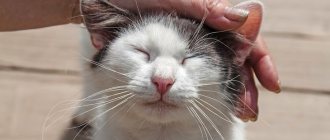Any situation that makes changes to the usual way of life can cause anxiety for a mustachioed pet. Each animal expresses it differently: it experiences fear, shows aggression, cries, asking a person for help, or simply gets mad.
In this state, it risks harming itself and others, as well as damaging furniture or wallpaper. To avoid sad consequences, you need to calm down a hyperactive kitten or an adult pet as soon as possible. The methods below will help you with this.
How to calm a kitten or adult cat when he's mad
Most often problems arise with kittens. Hyperactivity in children is the norm, explained by an inexhaustible supply of energy and increased excitability of the nervous system. Before acquiring a new family member, it is recommended to secure the apartment in the following ways:
- block or remove the blinds control chains;
- remove long curtains or replace them with shorter ones;
- place all fragile and valuable items in closed cabinets or on top shelves;
- Isolate access to wires, outlets and small spaces where you might accidentally get stuck.
Owners of older pets should also be on alert. Adults, like kids, love to play pranks, and the methods for calming them down are identical.
Distraction method
A toy, a sharp sound (clapping hands, whistling) or splashes from a spray bottle are suitable for distraction. By switching attention to another object, the cat will calm down a little and reduce its ardor.
Ignore method
It is recommended to use it every time a furious kitten begins to scratch and bite its legs. In such a situation, it is necessary to abruptly stop the game and leave the room, leaving the pet alone.
Education method
A combination of punishment and reward systems will help you get rid of bad behavior. The first includes:
- light tapping (but not a literal click) on the nose;
- spray from a spray bottle;
- gently grabbing the scruff of the neck and then pressing it to the floor.
Remember that you can punish a pet only at the moment of committing an offense or immediately after its completion. Delayed punishments do not work because animals quickly forget the events that happened.
Treats, praise and affection are suitable as rewards. They, like punishment, should be applied immediately after a certain action has been committed.
Food method
Reinforcement with food is only effective as a reward. If you use it every time your cat gets mad, it will make the unwanted behavior worse.
Give treats only if the pet reacts to your prohibitions. For encouragement, a special treat that is not included in the main diet is suitable.
How to calm an active kitten at night
With the onset of dusk, many mustachioed pets are possessed by demons. This is natural due to the nocturnal lifestyle, but is completely reversible. Changing your daily routine will help reduce activity. To do this you will need:
- move all outdoor games (running after a laser, chasing wind-up mice, rustling bows or teasing fishing rods) to the evening;
- Feed your pet tightly right before bedtime shortly after playing.
Please note that the completion of the game should be smooth. Stopping catching the teaser too abruptly is fraught with an attack on the legs and even greater madness.
The cleanliness of the tray and the availability of drinking water play a significant role. If the cat is not bothered by anything, then he is more likely to sleep with you until the morning.
It is also recommended to stop any activity in the bedroom. When sleeping together, your pet must distinguish between a place to play and rest.
Put some toys
To thrive, your kitten needs physical and mental activity. Buy him some toys. They don't have to be expensive. Provide enough toys that you can rotate every few weeks, which will help your pet combat his energy levels.
Pick up a few toy mice, ping pong balls and a couple of fluffy trinkets. Many kittens also like small balls with bells inside. Play with your kitten for at least half an hour every day. Along with toys, your pet needs attention and love, so it will become a real member of your family.
How to calm a scared cat or kitten
Another reason for restless behavior is fear caused by fear or nervous tension. It is expressed by the following behavioral changes:
- prolonged licking of one part of the body;
- very loud purring, soothing with its vibrations;
- indifference to food or unusual gluttony;
- perversion of appetite (eating inedible objects);
- hiding in dark and inaccessible places;
- profuse drooling;
- loud meowing or hissing;
- involuntary urination;
- freezing in place or an emergency attempt to hide from sight.
A cat can be frightened by a change in familiar surroundings, the appearance of a new family member, the sound of thunder, a trip to the veterinarian and other ordinary situations. To calm down, it is necessary to eliminate the cause of fear or prove that it does not pose a real danger.
Be sure to take into account the condition of your pet. Some will need consolation in the form of affection from the owner, while others will prefer to rethink everything alone.
In the first case, behave as usual. A voice that is too insinuating and comforting can increase the animal’s fear. It is better to act according to the following algorithm:
- Take a few steps back to give your cat more personal space. Don't try to pick her up.
- Start a normal conversation in a gentle and quiet voice, sitting on the floor. Being a little taller will reduce your potential danger.
- If the cat does not show aggression, approach and pet it. Otherwise, wait for her to take the initiative. Until this moment, you can hold out her favorite treat in your hand.
Particular attention should be paid to the environment. Isolate your pet from other animals and children by placing its sleeping area in the quietest and most protected area.
If you experience frequent attacks of fear, it is recommended to consult a veterinarian. In some situations, you cannot do without taking sedatives.
Try cat pheromones
Pheromone products for cats, such as diffusers and sprays, contain synthetic pheromones that mimic the pheromones produced by cats. They can be used around your furry friend to reduce stress and anxiety and promote a sense of calm. So it might be worth trying these products if you have a hyperactive kitten.
Just be sure to buy high-quality products from trusted brands and check the ingredient list to avoid unwanted additives such as essential oils that may be harmful to cats.
Posted by Lisa Selvaggio Lisa Selvaggio is a writer who has volunteered in animal rescue, caring for cats of all ages and learning about their many quirks. She is certified in therapeutic pet nutrition and enjoys helping pet parents care for their fur babies.
Source
Fighting aggression
Aggression occurs not only as a reaction to fear, but also for other reasons. Methods for calming a cat depend on the source of its anger.
How to recognize aggression
Most often, Pallas' cats, Savannah cats and Siamese cats show aggression. The following signs will help you recognize it:
- loud hissing and snorting;
- showing teeth;
- pressing the ears to the head;
- arching of the back;
- tail swelling;
- dilated pupils;
- release of claws.
If you notice that the cat is “on edge,” do not try to pet it. This can result in serious bites and deep scratches.
Methods to calm an angry animal
Act based on your specific situation. Every problem has its own solution:
- Pain. A sudden attack by a friendly and affectionate pet is most often explained by illness. If you haven't stepped on your cat's paw or pulled its tail, take it to the doctor.
- Territorial instinct. Battles for territory occur when several mature, uncastrated cats are kept together. The most reliable solution is surgical, that is, castration. Separating feeding areas and purchasing separate trays and beds can also help.
- Reaction to affection. Too frequent or overly active stroking quickly becomes boring and begins to irritate. Respect the interests of your pet and do not pet against its will.
- Fear. Provide the animal with a comfortable shelter and leave it alone.
- Rare games or ending too abruptly. Missing activity and unable to express its energy, the cat begins to throw itself on its legs and arms. The problem can be solved by increasing the frequency and duration of joint games, as well as by purchasing interactive toys.
- Protection of the cubs. A cat that has recently given birth can even attack its beloved owners. She needs to be given time to get used to the new role. For 2-3 weeks after birth, it is recommended not to disturb the pet over trifles and limit its communication with other household members.
- Unsatisfied sexual desire. It can occur in both male and female cats, but males show anger more often. An adult, uncastrated cat may well attack any person without warning under the influence of a sharp surge of hormones. If there are children living in the house, be sure to castrate or neuter your animal to avoid any trouble.
- Responsiveness. If a pet is beaten, it can respond in kind. The same reaction will occur to bullying or rough play.
Separately, it is worth noting cases of redirected aggression, when the target of the attack is not related to the real problem. Its main reason is the inaccessibility of the source of alarm: a sharp sound from the street, a bird or other animal outside the window.
Frequent attacks are treated only with sedatives, and isolated attacks are treated with emergency removal from the stressful place. To do this, use a thick blanket or other dense fabric that needs to be thrown over the angry cat.
It also happens that aggression is causeless - in this case we are talking about shifts in the psyche. Such deviations can only be treated under the supervision of a veterinarian.
Let your kitten roam safely in nature
If you think your kitten is hyperactive because he has a lot of energy and is tired of being indoors, letting him explore nature in your own backyard for a while may be just what he needs.
Whether you're building or buying an outdoor enclosure or purchasing a large outdoor cat enclosure, you can sit outside with your kitty while she enjoys the fresh air and sun, watches birds and insects, and finds new and exciting ways to release her energy.
How to calm a crying animal
Streams from the eyes, accompanied by a plaintive meow, are often used to attract attention. The accompanying symptoms will help you understand the cause of anxiety and tears.
Little kitten
A baby's squeak is usually associated with moving to a new family. At first, he misses his mother a lot and is frightened by unusual smells.
To begin, pick up the kitten, pet it and talk to it. Try playing with it and see the reaction. If it's a lack of attention, these steps can help.
It is also recommended to check the cleanliness of the tray and the amount of food and water left in the bowls. Arranging a personal corner plays a significant role. Try to make it as warm and cozy as possible by adding a soft blanket and toys.
teenager
Excessive lacrimation in adolescents occurs due to a temporary discrepancy between the width and length of the tear ducts. At this stage of maturation, the length does not slightly keep up with the width, which increases sharply with the growing head. You just need to wait out this moment.
If your teenager is really experiencing emotional distress, distract him with games. For maturing kittens, this is the best way.
Adult pet
The crying of an adult pet can be associated with psychological discomfort, hunger, thirst or lack of attention. Try to minimize existing stress by filling bowls and increasing the amount of time you play together.
How to help if something hurts with a mustache
The feeling of pain is easy to identify by general malaise. A sick pet will hide, refuse to eat, have a fever, or relieve itself in the wrong place. Depending on the diagnosis, the painful condition may be accompanied by vomiting, stool upset, bloating and other alarming symptoms. To determine the exact cause of the malaise, you need to contact a veterinarian.
What to do with an overly active cat?
The moment a cat appeared in your house, everything that could be broken, torn or eaten disappeared from it.
Spartan order reigns in the apartment, but the “fluffy vandal” still burns with an insatiable thirst for activity and is looking for the next opportunity to cause mischief.
How can you explain your pet's restless behavior?
1. Youth. Some cats need to grow up and settle down.
2. Change of environment (moving, renovation). Each four-legged pet reacts in its own way to unfamiliar smells, new furniture, street noise coming from behind the door of a new apartment, and so on.
How to make an animal calm before a hygiene procedure or at the veterinarian
If you carry out hygiene procedures yourself, use a clothespin or a stationery clip measuring 5 cm. Fix them on the withers to deactivate your pet while trimming its nails.
For especially restless comrades, a special retainer bag is suitable. Only the pet's head remains outside, and the paws can be pulled out from the front.
In other cases, it is recommended to take sedatives. You should prepare for planned events with the help of sedatives with a cumulative effect, and for emergency trips to the veterinary clinic with the help of sedatives with an immediate effect. They will be prescribed by the veterinarian himself over the phone.
If your cat tolerates the journey and visits to the veterinary clinic relatively calmly, you can do without preparatory measures and without sedatives.
How to pacify an animal's sexual heat
Aggression and hyperactivity during the period of sexual heat are characteristic of both sexes. There are only 3 possible solutions:
- taking hormonal drugs that suppress desire;
- regular mating with other animals;
- castration or sterilization.
The first option is allowed only as a temporary one. Frequent changes in hormonal levels are fraught with oncology and other dangerous diseases.










